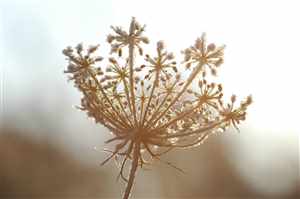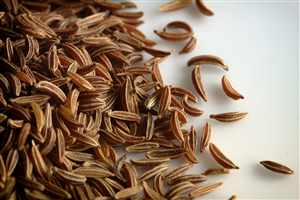Caraway (Carum carvi)
Main Facts about Caraway

Caraway is an annual or biennial plant with divided fernlike leaves and a parsley-dill fragrance. It has a spindle-shaped taproot, which can be cooked like carrot. The flowering stem, about 2 feet (60 cm) tall, bears white or pink flower umbels that are followed by crescent-shaped ridged “seeds”. Caraway flowers in spring. Parts used – leaves, seeds, and roots.
A member of the parsley family, Caraway was a popular Middle Eastern herb before being introduced into Western Europe in the 12th century. Caraway seed (which technically is a fruit) has been used medicinally and in cooking since at least 3500 B.C. This herb is one of the few whose primary medicinal use (as a digestive aid) has remained the same throughout history. Caraway seeds were recommended for digestive upsets in the Ebers Papyrus, one of the world’s oldest surviving medical documents. Throughout history, in Europe, the Middle East, and early America, Caraway was a favorite addition to laxative herbs because it tempered their effects.
Using Caraway

The herb has a long history of use for the treatment of flatulence, intestinal colic and bloating. As a result of its slightly drying nature, it is also prescribed with other appropriate herbs to assist in the relief of diarrhea.
Like Peppermint, it helps to decrease spasm in the muscles of the digestive tract, and the essential oils of the two herbs are sometimes combined in commercial products.
Caraway also has antispasmodic properties and may be useful in the treatment of menstrual cramps and diarrhea. The aroma of the oil is said to be calming and soothing.
For an infusion that may aid digestion, relieve gas or menstrual cramping, use 2 to 3 tsp of crushed seeds per cup of boiling water. Steep for 10 to 20 min, then strain. Drink up to 3 cups a day.
Cooking with Caraway

The minced fresh leaves, which have a mild flavor similar to the seeds, can be added to salads, soups, and casseroles. Even the root can be used, steamed, pureed, or chopped, and added to winter stews.
Caraway seed can become bitter if cooked for too long; add it only during the last few minutes of cooking.
How to grow Caraway
Caraway requires a well-drained fertile soil and a warm sunny position. Sow Caraway seed directly into the soil in spring ½ inch deep and 8 inches apart. Keep them moist but not wet.
The first year, Caraway produces a small rosette of leaves and a long tap root. Don’t transplant it once it has become established. During the second year, Caraway sends up its stem, reveals its leaves, and produces its seeds. Gather leaves at any time.
Seeds appear in midsummer. Harvest them as soon as they ripen (they turn brown). Snip entire stems and hang them upside down over a paper-lined tray to finish drying. After a few weeks, when the seeds are completely dry, store them in an airtight container for future use. Leave some seeds behind, and the plants will self-sow.
| Calendula |
Cardamom
|